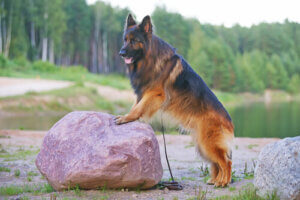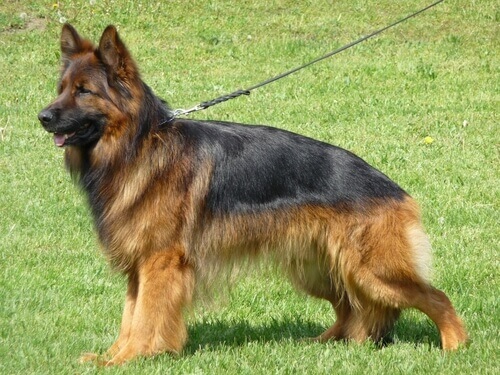Caring for Your German Shepherd's Coat

The German Shepherd is one of the most beloved dog breeds in the entire world. It stands out both for its stature and its noble character. What’s more, it makes an excellent companion and guardian. The German Shepherd’s coat doesn’t require a great deal of care. Just the same, we’ll offer a few tips to keep your pet’s hair in top condition.
The German Shepherd’s coat
German Shepherds, or Alsatians, are large dogs with a robust body. Therefore, they require certain care every once in a while in order to stay healthy. The good news is that they don’t require a great deal of special care, given the fact that they’re meant to live outdoors.
These dogs possess an abundant outer layer of hair, which is quite wavy and strong. This layer is resistant to the rigors of hard work. At the same time, the German Shepherd’s coat consists of an inner layer that provides warmth. At the same time, it provides additional protection from external agents.
The animal’s skin is also very strong and resistant to minor lacerations that can occur while working. Without a doubt, this dog is ideal for putting up with tough country life. And, thanks to evolution, it doesn’t take much effort to keep a German Shepherd’s coat in good shape.

Caring for your German’s Shepherd’s coat
Given the amount of hair these animals shed, it’s important to brush them on a regular basis. This will help you keep their coat healthy and shiny. During the months when these animals shed the most, brushing becomes even more essential. Proper care will help eliminate dead hair that can make their coat appear dull.
To brush German Shepherds, you can use any brush with medium or long bristles. However, we recommend using one with long, thin metallic bristles, which is much more effective. The places where you should pay the most attention when brushing are the head, torso, and back thighs.
German Shepherds tend to shed their fur twice a year. So, during these seasons, you should make a habit of brushing your pet more than two times a week. The great thing is that this breed adapts well to any type of climate, so don’t worry about the acclimatization of your dog.
Tips for cleaning your German Shepherd’s coat
When it comes to hygiene, you only need to bathe your German Shepherd when its coat is very dirty. We’re talking about a breed that doesn’t require a lot of care because it takes care of itself. What’s more, it doesn’t release a lot of body oils, so unpleasant odors don’t tend to be an issue.

If you notice that your dog needs a bath, here are a few tips about how to go about it the right way and avoid struggles:
- Before bathing German Shepherds, you should always brush them first. This will prevent their hair from clogging up your drains and will also help to keep your dog calm.
- Brush in the same direction as growth and never against it. This helps release the fur and is also more relaxing.
- Use plenty of water when rinsing your dog off. Also, avoid the ears and eyes, as this is bothersome to dogs and can even lead to infection.
- Only use shampoos and conditioners that are suitable for your pet. Products designed for humans can cause severe reactions in your dog’s skin.
- Be sure to remove all soap residue from your dog’s body. Otherwise, you run the risk of skin irritations and clumping in your dog’s hair.
- Remember to brush your dog’s hair once again after bath time. That way, you’ll eliminate any hair that’s loosened during the bath and save yourself trouble in the future.
As for their ears and legs, you should be especially careful. Wax can build up in the hair inside their ears and cause clumps that can decrease their hearing. As for their legs, you need to be careful to prevent and eliminate knots.
The German Shepherd is one of the most beloved dog breeds in the entire world. It stands out both for its stature and its noble character. What’s more, it makes an excellent companion and guardian. The German Shepherd’s coat doesn’t require a great deal of care. Just the same, we’ll offer a few tips to keep your pet’s hair in top condition.
The German Shepherd’s coat
German Shepherds, or Alsatians, are large dogs with a robust body. Therefore, they require certain care every once in a while in order to stay healthy. The good news is that they don’t require a great deal of special care, given the fact that they’re meant to live outdoors.
These dogs possess an abundant outer layer of hair, which is quite wavy and strong. This layer is resistant to the rigors of hard work. At the same time, the German Shepherd’s coat consists of an inner layer that provides warmth. At the same time, it provides additional protection from external agents.
The animal’s skin is also very strong and resistant to minor lacerations that can occur while working. Without a doubt, this dog is ideal for putting up with tough country life. And, thanks to evolution, it doesn’t take much effort to keep a German Shepherd’s coat in good shape.

Caring for your German’s Shepherd’s coat
Given the amount of hair these animals shed, it’s important to brush them on a regular basis. This will help you keep their coat healthy and shiny. During the months when these animals shed the most, brushing becomes even more essential. Proper care will help eliminate dead hair that can make their coat appear dull.
To brush German Shepherds, you can use any brush with medium or long bristles. However, we recommend using one with long, thin metallic bristles, which is much more effective. The places where you should pay the most attention when brushing are the head, torso, and back thighs.
German Shepherds tend to shed their fur twice a year. So, during these seasons, you should make a habit of brushing your pet more than two times a week. The great thing is that this breed adapts well to any type of climate, so don’t worry about the acclimatization of your dog.
Tips for cleaning your German Shepherd’s coat
When it comes to hygiene, you only need to bathe your German Shepherd when its coat is very dirty. We’re talking about a breed that doesn’t require a lot of care because it takes care of itself. What’s more, it doesn’t release a lot of body oils, so unpleasant odors don’t tend to be an issue.

If you notice that your dog needs a bath, here are a few tips about how to go about it the right way and avoid struggles:
- Before bathing German Shepherds, you should always brush them first. This will prevent their hair from clogging up your drains and will also help to keep your dog calm.
- Brush in the same direction as growth and never against it. This helps release the fur and is also more relaxing.
- Use plenty of water when rinsing your dog off. Also, avoid the ears and eyes, as this is bothersome to dogs and can even lead to infection.
- Only use shampoos and conditioners that are suitable for your pet. Products designed for humans can cause severe reactions in your dog’s skin.
- Be sure to remove all soap residue from your dog’s body. Otherwise, you run the risk of skin irritations and clumping in your dog’s hair.
- Remember to brush your dog’s hair once again after bath time. That way, you’ll eliminate any hair that’s loosened during the bath and save yourself trouble in the future.
As for their ears and legs, you should be especially careful. Wax can build up in the hair inside their ears and cause clumps that can decrease their hearing. As for their legs, you need to be careful to prevent and eliminate knots.
This text is provided for informational purposes only and does not replace consultation with a professional. If in doubt, consult your specialist.








